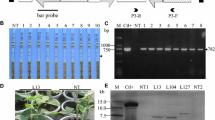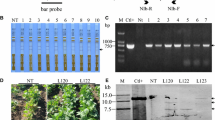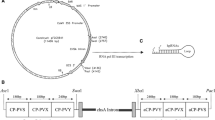Abstract
Australian bean common mosaic virus (BCMV) isolates were sequenced, and the sequences were compared to global BCMV and bean common mosaic necrosis virus (BCMNV) sequences and analysed for conserved potyviral motifs to generate in planta RNA-interference (RNAi) resistance. Thirty-nine out of 40 previously reported potyvirus motifs were conserved among all 77 BCMV/BCMNV sequences. Two RNAi target regions were selected for dsRNA construct design, covering 920 bp of the nuclease inclusion b (NIb) protein and 461 bp of the coat protein (CP). In silico prediction of the effectiveness of these constructs for broad-spectrum defence against the 77 BCMV and BCMNV sequences was done via analysis of putative 21-nucleotide (nt) and 22-nt small-interfering RNAs (siRNAs) generated from the target regions. The effectiveness of both constructs for siRNA generation and BCMV RNAi-mediated resistance was validated in Nicotiana benthamiana transient assays.




Similar content being viewed by others
References
International Service for the Acquisition of Agri-Biotech Applications (ISAAA) (2018) Bean (Phaseolus vulgaris) GM Events
Aleman-Verdaguer M-E, Goudou-Urbino C, Dubern J, Beachy RN, Fauquet C (1997) Analysis of the sequence diversity of the P1, HC, P3, NIb and CP genomic regions of several yam mosaic potyvirus isolates: implications for the intraspecies molecular diversity of potyviruses. J Gen Virol 78:1253–1264
Anuradha C, Balasubramanian V, Selvarajan R (2015) Sequence motif comparison and homology modeling of helper component proteinase (HC–Pro) of banana bract mosaic virus.
Bartel D (2004) MicroRNAs: genomics, biogensis, mechanism and function. Cell 116:281–297
Baulcombe D (2004) RNA silencing in plants. Nature 431:356–363
Bhadramurthy V, Bhat A (2009) Biological and molecular characterization of Bean common mosaic virus associated with vanilla in India. Indian J Virol 20:70–77
Bonfim K, Faria JC, Nogueira EO, Mendes ÉA, Aragão FJ (2007) RNAi-mediated resistance to Bean golden mosaic virus in genetically engineered common bean (Phaseolus vulgaris). Mol Plant-microbe Interact 20:717–726
Borges F, Martienssen RA (2015) The expanding world of small RNAs in plants. Nat Rev Mol Cell Biol 16:727
Bravo E, Calvert LA, Morales FJ (2008) The complete nucleotide sequence of the genomic RNA of bean common mosaic virus strain nl4. Rev Acad Colomb Cienc Exactas 32:37–46
Brosnan C, Mitter N, Christie M, Smith N, Waterhouse P, Carroll B (2007) Nuclear gene silencing directs reception of long-distance mRNA silencing in Arabidopsis. Proc Natl Acad Sci 104:14741–14746
Burand JP, Hunter WB (2013) RNAi: Future in insect management. J Invertebr Pathol 112:S68–S74
Cheng G, Dong M, Xu Q, Peng L, Yang Z, Wei T, Xu J (2017) Dissecting the molecular mechanism of the subcellular localization and cell-to-cell movement of the sugarcane mosaic virus P3N-PIPO. Sci Rep 7:9868
Damayanti T, Susilo D, Nurlaelah S, Sartiami D, Okuno T, Mise K (2008) First report of Bean common mosaic virus in yam bean [Pachyrhizus erosus (L.) Urban] in Indonesia. J Gen Plant Pathol 74:438–442
Duan C-G, Wang C-H, Guo H-S (2012) Application of RNA silencing to plant disease resistance. Silence 3:5
El-Sawy MA, Mohamed HAE, Elsharkawy MM (2013) Serological and molecular characterisations of the Egyptian isolate of Bean common mosaic virus. Arch Phytopathol Plant Protect 47:1–13
Flores-Estévez N, Acosta-Gallegos J, Silva-Rosales L (2003) Bean common mosaic virus and Bean common mosaic necrosis virus in Mexico. Plant disease 87:21–25
Gleave AP (1992) A versatile binary vector system with a T-DNA organisational structure conducive to efficient integration of cloned DNA into the plant genome. Plant Mol Biol 20:1203–1207
Gong D, Wang J-H, Lin Z-S, Zhang S-Y, Zhang Y-L, Yu N-T, Xiong Z, Liu Z-X (2011) Genomic sequencing and analysis of Chilli ringspot virus, a novel potyvirus. Virus Genes 43:439–444
Gordon KH, Waterhouse PM (2007) RNAi for insect-proof plants. Nat Biotechnol 25:1231–1232
Guyatt K, Proll D, Menssen A, Davidson A (1996) The complete nucleotide sequence of bean yellow mosaic potyvirus RNA. Arch Virol 141:1231–1246
Hamid A, Ahmad M, Padder B, Shah M, Saleem S, Sofi T, Mir A (2013) Pathogenic and coat protein characterization confirming the occurrence of Bean common mosaic virus on common bean (Phaseolus vulgaris) in Kashmir, India. Phytoparasitica 42:1–6
Ivanov K, Eskelin K, Lõhmus A, Mäkinen K (2014) Molecular and cellular mechanisms underlying potyvirus infection. J Gen Virol 95:1415–1429
Ivanov KI, Mäkinen K (2012) Coat proteins, host factors and plant viral replication. Curr Opin Virol 2:712–718
Kamenova I, Lohuis H, Peters D (2002) Loss of aphid transmissibility of plum pox virus isolates. Biotechnol Biotechnol Equip 16:48–54
Kelly J, Afanador L, Haley S (1995) Pyramiding genes for resistance to Bean common mosaic virus. Euphytica 82:207–212
Knierim D, Menzel W, Winter S (2017) Analysis of the complete genome sequence of euphorbia ringspot virus, an atypical member of the genus Potyvirus. Arch Virol 162:291–293
Koch A, Biedenkopf D, Furch A, Weber L, Rossbach O, Abdellatef E, Linicus L, Johannsmeier J, Jelonek L, Goesmann A (2016) An RNAi-based control of Fusarium graminearum infections through spraying of long dsRNAs involves a plant passage and is controlled by the fungal silencing machinery. PLoS Pathog 12:e1005901
Kwapata K, Nguyen T, Sticklen M (2012) Genetic transformation of common bean (Phaseolus vulgaris L.) with the gus color marker, the bar herbicide resistance, and the barley (Hordeum vulgare) HVA1 drought tolerance genes. Int J Agron 2012:1–8
Li F, Xu D, Abad J, Li R (2012) Phylogenetic relationships of closely related potyviruses infecting sweet potato determined by genomic characterization of Sweet potato virus G and Sweet potato virus 2. Virus Genes 45:118–125
Li Y, Jia A, Qiao Y, Xiang J, Zhang Y, Wang W (2017) Virome analysis of lily plants reveals a new potyvirus. Arch Virol 163:1–4
Li YQ, Liu ZP, Yang YS, Zhao B, Fan ZF, Wan P (2014) First report of Bean common mosaic virus infecting Azuki bean (Vigna angularis Ohwi & Ohashi) in China. Plant Disease 98:1017
Liang WX, Song LM, Tian GZ, Li HF, Fan ZF (2006) The genomic sequence of Wisteria vein mosaic virus and its similarities with other potyviruses. Arch Virol 151:2311–2319
Lilley C, Davies L, Urwin P (2012) RNA interference in plant parasitic nematodes: a summary of the current status. Parasitology 139:630–640
Lin J-J (1995) Electrotransformation of Agrobacterium. 171–178
Lopez-Moya J, Wang R, Pirone T (1999) Context of the coat protein DAG motif affects potyvirus transmissibility by aphids. J Gen Virol 80:3281–3288
Maillard P, Ciaudo C, Marchais A, Li Y, Jay F, Ding S, Voinnet O (2013) Antiviral RNA interference in mammalian cells. Science 342:235–238
Mangrauthia SK, Jain R, Praveen S (2008) Sequence motifs comparisons establish a functional portrait of a multifunctional protein HC-Pro from papaya ringspot potyvirus. J Plant Biochem Biotechnol 17:201–204
Mann KS, Johnson KN, Dietzgen RG (2015) Cytorhabdovirus phosphoprotein shows RNA silencing suppressor activity in plants, but not in insect cells. Virology 476:413–418
Maoka T, Hataya T (2005) The complete nucleotide sequence and biotype variability of Papaya leaf distortion mosaic virus. Phytopathology 95:128–135
Mishra R, Verma RK, Gaur RK (2015) Analysis of genome comparison of two Indian isolates of Cowpea aphid-borne mosaic virus from India. Virus Genes 51:306–309
Mitter N, Worrall EA, Robinson KE, Li P, Jain RG, Taochy C, Fletcher SJ, Carroll BJ, Lu G, Xu ZP (2017) Clay nanosheets for topical delivery of RNAi for sustained protection against plant viruses. Nat Plants 3:16207
Moghal S, Francki R (1976) Towards a system for the identification and classification of potyviruses: I. Serology and amino acid composition of six distinct viruses. Virology 73:350–362
Moradi Z, Mehrvar M, Nazifi E, Zakiaghl M (2017) Iranian johnsongrass mosaic virus: the complete genome sequence, molecular and biological characterization, and comparison of coat protein gene sequences. Virus Genes 53:77–88
Moura MF, Marubayashi JM, Mituti T, Gioria R, Kobori RF, Pavan MA, Krause-Sakate R (2012) Comparative analysis of coding region for the coat protein of PepYMV and PVY isolates collected in sweetpepper. Summa Phytopathol 38:93–96
Mukeshimana G, Paneda A, Rodríguez-Suárez C, Ferreira JJ, Giraldez R, Kelly JD (2005) Markers linked to the bc-3 gene conditioning resistance to bean common mosaic potyviruses in common bean. Euphytica 144:291–299
Pasev G, Kostova D, Sofkova S (2014) Identification of genes for resistance to Bean common mosaic virus and Bean common mosaic necrosis virus in snap bean (Phaseolus vulgaris L.) breeding lines ssing conventional and molecular methods. J Phytopathol 162:19–25
Perotto MC, Pozzi EA, Celli MG, Luciani CE, Mitidieri MS, Conci VC (2018) Identification and characterization of a new potyvirus infecting cucurbits. Arch Virol 163:719–724
Puli’uvea C, Khan S, Chang W-L, Valmonte G, Pearson MN, Higgins CM (2017) First complete genome sequence of vanilla mosaic strain of Dasheen mosaic virus isolated from the Cook Islands. Arch Virol 162:591–595
Rajamäki M, Merits A, Rabenstein F, Andrejeva J, Paulin L, Kekarainen T, Kreuze J, Forster R, Valkonen J (1998) Biological, serological, and molecular differences among isolates of potato A potyvirus. Phytopathology 88:311–321
Revers F, Garcia J (2015) Molecular biology of potyviruses. Adv Virus Res 92:101–199
Rojas MR, Zerbini FM, Allison RF, Gilbertson RL, Lucas WJ (1997) Capsid protein and helper component-proteinase function as potyvirus cell-to-cell movement proteins. Virology 237:283–295
Saqib M, Jones RAC, Cayford B, Jones MGK (2005) First report of Bean common mosaic virus in Western Australia. Plant Pathol 54:563
Saqib M, Nouri S, Cayford B, Jones RAC, Jones MGK (2010) Genome sequences and phylogenetic placement of two isolates of Bean common mosaic virus from Macroptilium atropurpureum in north-west Australia. Aust Plant Pathol Soc 39:184–191
Sastry KS (2013) Mechanism of seed transmission. Seed-borne plant virus diseases. Springer, Heidelberg, pp 85–100
Sengooba TN, Spence NJ, Walkey DGA, Allen DJ, Femi Lana A (1997) The occurrence of Bean common mosaic necrosis virus in wild and forage legumes in Uganda. Plant Pathol 46:95–103
Shapter FM, Waters DL Genome walking T cereal genomics, pp 133–146
Shukla DD, Frcnkel M, Ward CW (1991) Structure and function of the potyvirus genome with special reference to the coat protein coding region. Can J Plant Pathol 13:178–191
Silbernagel MJ, Mink GI, Zhao RL, Zheng GY (2001) Phenotypic recombination between bean common mosaic and bean common mosaic necrosis potyviruses in vivo. Arch Virol 146:1007–1020
Singh SP, Schwartz HF (2010) Breeding common bean for resistance to diseases: a review. Crop Sci 50:2199–2223
Spence N, Walkey D (1995) Variation for pathogenicity among isolates of Bean common mosaic virus in Africa and a reinterpretation of the genetic relationship between cultivars of Phaseolus vulgaris and pathotypes of BCMV. Plant Pathol 44:527–546
Urchqui-Inchima S, Haenni A-L, Bernardi F (2001) Potyvirus proteins: a wealth of functions. Virus Res 74:157–175
Valli A, López-Moya JJ, García JA (2007) Recombination and gene duplication in the evolutionary diversification of P1 proteins in the family Potyviridae. J Gen Virol 88:1016–1028
Velasco L, Salem N, Willemsen A, Lapidot M, Mansour AN, Rubio L, Galipienso L (2016) Genetic variation and evolutionary forces shaping Cucumber vein yellowing virus populations: risk of emergence of virulent isolates in Europe. Plant Pathol 65:847–856
Verma P, Gupta U (2010) Immunological detection of Bean common mosaic virus in French bean (Phaseolus vulgaris L.) leaves. Indian j Microbiol 50:263–265
Worrall EA, Wamonje FO, Mukeshimana G, Harvey JJ, Carr JP, Mitter N (2015) Bean common mosaic virus and Bean common mosaic necrosis virus: relationships, biology, and prospects for control. Adv Virus Res 93:1–46
Zheng L, Wayper PJ, Gibbs AJ, Fourment M, Rodoni BC, Gibbs MJ (2008) Accumulating variation at conserved sites in potyvirus genomes is driven by species discovery and affects degenerate primer design. PLoS One 3:e1586
Acknowledgments
The authors would like to thank Queensland Alliance of Agriculture and Food Innovation (QAAFI), Australia and the University of Queensland, Australia, for their support.
Funding
This study was funded by the Accelerated Partnership Grant, Queensland Government (2014000652), awarded to N.M. with Nufarm Australia Limited as the industry partner. E.A.W. PhD programme with N.M. is supported by a scholarship from the University of Queensland.
Author information
Authors and Affiliations
Corresponding author
Ethics declarations
Conflict of interest
The authors declare that they have no conflict of interest.
Ethical approval
This article does not contain any studies with human participants or animals performed by any of the authors.
Data availability
The datasets generated and/or analysed during the current study are available in the NCBI GenBank repository, https://www.ncbi.nlm.nih.gov. Only complete genomes of BCMV and BCMNV were used.
Additional information
Handling Editor: F. Murilo Zerbini.
Electronic supplementary material
Below is the link to the electronic supplementary material.
Rights and permissions
About this article
Cite this article
Worrall, E.A., Hayward, A.C., Fletcher, S.J. et al. Molecular characterization and analysis of conserved potyviral motifs in bean common mosaic virus (BCMV) for RNAi-mediated protection. Arch Virol 164, 181–194 (2019). https://doi.org/10.1007/s00705-018-4065-6
Received:
Accepted:
Published:
Issue Date:
DOI: https://doi.org/10.1007/s00705-018-4065-6




